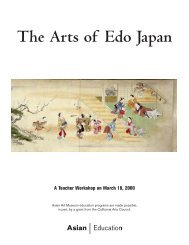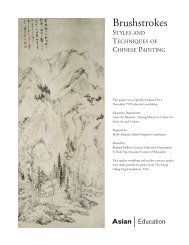Sacred Arts of Tibet (.pdf) - Asian Art Museum | Education
Sacred Arts of Tibet (.pdf) - Asian Art Museum | Education
Sacred Arts of Tibet (.pdf) - Asian Art Museum | Education
Create successful ePaper yourself
Turn your PDF publications into a flip-book with our unique Google optimized e-Paper software.
<strong>Sacred</strong> <strong><strong>Art</strong>s</strong> <strong>of</strong> <strong>Tibet</strong><br />
for advanced training in <strong>Tibet</strong>. The <strong>Tibet</strong>an monastic universities, such as Drepung, Sera, Ganden, Tashi<br />
Lhunpo, Kumbum and Lhabrang Trashi Kyil each housed and taught many thousands <strong>of</strong> students, scholars<br />
and artisans. There they could learn the fine arts, medicine, natural sciences, literature, philosophy<br />
and every aspect <strong>of</strong> the ancient religious lore <strong>of</strong> <strong>Tibet</strong>. Having completed their education, many would<br />
return to their homelands and become the principle teachers in their own schools and universities. Over<br />
six thousand such monastic universities, with their great libraries and teaching facilities, existed in <strong>Tibet</strong><br />
in 1959. Within seven years, the invading Chinese armies had destroyed all but sixteen. Those sixteen<br />
were converted by the Chinese into government facilities and museums for tourists.<br />
All <strong>of</strong> these diverse social roles, except for perhaps the nomad, have changed or disappeared within <strong>Tibet</strong><br />
since 1959.<br />
Nomads<br />
Nomads <strong>of</strong> northern <strong>Tibet</strong> constitute one <strong>of</strong> the last great nomadic pastoral societies once found in the<br />
world today. This lifestyle has survived in northern <strong>Tibet</strong> because no one has discovered an alternative<br />
means <strong>of</strong> survival. There are no competitors for the land, since it cannot be farmed. The Chinese use<br />
some <strong>of</strong> it as a dumping ground for nuclear waste, mine it for minerals, but find the life there too harsh.<br />
In the north, nomads convert the energy <strong>of</strong> the wild grasses into food, clothing, and shelter by means<br />
<strong>of</strong> the large herds they tend. They are dependent on their animals for survival in the way that American<br />
plains Indians were dependent upon the buffalo. Like Buffalo Bill and his henchmen in the American Far<br />
West during the nineteenth century, the Chinese have sought to demoralize and economically destroy the<br />
nomads <strong>of</strong> <strong>Tibet</strong> by confiscating or killing their herds <strong>of</strong> yak.<br />
Nomads value their freedom and self-sufficiency above all else. They live in collapsible yak-hair tents,<br />
which they can pack on the strong backs <strong>of</strong> their yaks and move to their next seasonal pasture. A complicated<br />
system <strong>of</strong> rotation <strong>of</strong>ten causes families to wander for extended periods <strong>of</strong> time, since different families<br />
tend different animals in the widely scattered feeding grounds. Often alone with their animals, the life<br />
a nomad is a solitary but free one. The landscapes <strong>of</strong> the northern part <strong>of</strong> <strong>Tibet</strong> provide some <strong>of</strong> the most<br />
spectacular scenery on earth.<br />
As in most other <strong>Asian</strong> cultures, the family is the basic economic unit. Nomad women, however, hold a<br />
much higher role in their society than their counterparts in other cultures. The children start to work as<br />
shepherds from a very early age, steering the groups <strong>of</strong> animals with pebble slings and sheep dogs. This is<br />
a great responsibility, for the nomads eke out a living almost entirely from their herds; the family’s survival<br />
depends on the survival <strong>of</strong> their animals, which they must protect from wolves and other calamities. Most<br />
chores have to be done outside regardless <strong>of</strong> the weather, so the nomadic lifestyle is <strong>of</strong>ten looked upon as<br />
harsh. Compared to the farmer, however, the nomads say their life is easy. The grass is already there.<br />
A family will always have its investments distributed among different animals to ensure that all their<br />
needs are met. The staples <strong>of</strong> the nomads are meat, milk, butter, cheese, yogurt, and salt, which they collect<br />
from the brackish lakes that dot the north. The harsh environment demands that the nomads eat<br />
some meat to survive, but because there is such a strong Buddhist taboo against killing, nomads depend<br />
upon animals who have died a natural death. To obtain what herds cannot produce directly they trade<br />
with farmers and merchants. In exchange for salt and wool, they receive agricultural products like barley,<br />
the major staple <strong>of</strong> the <strong>Tibet</strong>an diet, and imported goods such as tea.<br />
6<br />
<strong>Asian</strong> <strong>Art</strong> <strong>Museum</strong>
















